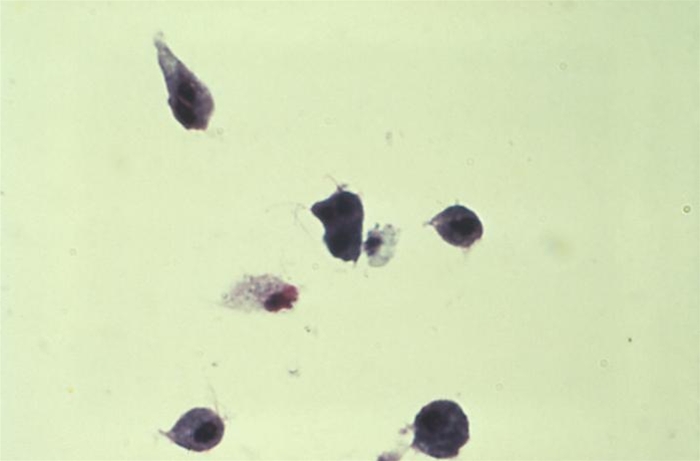Facts About Trichomonas Vaginalis
- Trichomonas vaginalis is a parasitic infection of the vagina or urethra
- The infection is frequent in many parts of the world, but rare in South Africa
- Symptoms are foamy, yellowish-greenish, foul-smelling discharge. There may also be itching and irritation in and outside the vagina. One can also get a burning sensation when urinating, when the parasite allows infection of the urethra
- The infection is effectively treated with antibiotics
- Use of condoms reduces the risk of becoming infected with T. vaginalis. It is important that one’s sexual partner (s) will also be examined and treated
What is an infection of the vagina and urethra with trichomonas?

Inflammation of the vagina and / or urethra with trichomonas is caused by the parasite Trichomonas vaginalis,and is also called skedekatar with trichomonas or trichomonas vaginitis.
How common is a vaginal infection with trichomonas?
Infection with trichomonas is now rare in South Africa, but it is still frequent in several places in the world.
How do you get trichomonas?
Trichomonas is sexually transmitted.
What are the symptoms of trichomonas?
Typical symptoms of trichomonas is foamy, yellowish-greenish vaginal discharge with an unpleasant odor. One can have itching inside and outside the vagina, burning on urination and discomfort in the lower abdomen. In up to half of cases in women sees no symptoms. In men, it is up to 3/4 of the cases.
What symptoms should you pay particular attention to?
Trichomonas can cause premature birth in pregnant
How is it diagnosed?
The diagnosis is made based on symptoms and a gynecological examination. At a gynecological examination appears udflådet as “foaming”. Microscopy of udflådet shows the typical parasitics that swim lively around with their tail (flagellum). Trichomonas can also be detected by a grafting study to the culture or DNA amplification method.
What treatment is there?
Trichomonas is being treated with metronidazole. Metronidazole is an antibiotic that kills the parasite effectively. The substance can be given as a single dose in tablet form. During treatment and in the following three days you should avoid alcohol. The mixture of alcohol and metronidazole may in particular cause nausea and heat sensation on the face. You should not have intercourse when you have symptoms. Your partner should also be treated.
How is long-term prospects?
The disease is harmless and is quickly cured by treatment.
How do I avoid trichomonas and how do I avoid trichomonas deteriorate?
Condom reduces the risk of infection with trichomonas. It is important that one’s sexual partner (s) will also be examined and treated Otherwise, you risk getting infected again and the infection can spread to others.
Basic information
Definition
- Infection of the vagina and / or urethra caused by Trichomonas vaginalis
Occurrence
- Is now rare in South Africa. A South African study showed that the prevalence in South Africa for the period 1967-1997 of Trichomonas vaginalis positive specimens received SSI fell from 19% to under 2%
- Trichomonas vaginalis is the most common sexually transmitted non viral infection worldwide. The prevalence varies from 3-48%1
- WHO has estimated that Trichomonas vaginalis causes 275 million sexually transmitted infections annually worldwide2
Etiology and pathogenesis
- Infection of the vagina and urethra of the movable, parasitic protozoan Trichomonas vaginalis
- Transmitted through sexual intercourse
- Transmission rate between sexual partners is high. A study thus found that 70% of exposed men become infected1, The transmission rate from man to woman is found even higher 3
- The parasite can survive up to 45 minutes on the toilet seats and towels. Non-sexual transmission can occur in rare cases3
ICPC 2
- X73 Trichomonas infection of the genital tract in women
ICD-10
- A59 Infections m Trichomonas vaginalis
- A590 Trichomoniasis urinary and reproductive organs
- A598 Trichomoniasis other localization m
- A599 Trichomoniasis UNS
Diagnosis
Diagnostic criteria
- Typically, medical history and clinical findings
- The diagnosis is confirmed by detection of Trichomonas vaginalis by direct microscopy or culture (charcoal swabs and Stuart’s Medium) and PCR
Differential
- chlamydia Infection
- gonorrhea
- Candida vaginitis
- bacterial vaginosis
Medical history
- Incubation period is 4-28 days
- 10-50% of women with Trichomonas vaginalis infection is asymptomatic, this proportion is higher for men
- Symptoms vary from intense freedom from symptoms for generating:
- Itching of the vulva and vagina
- Plenty smelly thin vaginal discharge, often with a grayish to greenish yellow color
- Dysuria, seen in about 1/3 of women with Trichomonas vaginalis infection
- The symptoms may be accompanied by abdominal discomfort / pain
Clinical findings
- Increased amount of discharge often foamy greyish or yellowish green
- unpleasant odor
- Diffuse vaginal erythema, possibly. petechiae
- Possibly. vulvitis with erythema and edema
- <5% the influence of the cervix with colpitis macularis “strawberry cervix” as the expression of bleeding punctate
